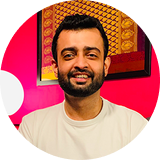Journals
How I transitioned from Finance to Product Design (without a Design Degree)

Life changes are always scary, but not always wrong. If you are thinking about switching your career, no matter your age or experience, don’t be afraid if you have the right reasons to do so. In this article, I would like to share my journey on how I transitioned from working as a research analyst at a Big 4 corporation to becoming a Product Designer. I’ve structured this article in steps that you could follow to set your path into this field.
Setting Expectations
Before even drafting a plan, I extensively read job descriptions of entry level design roles to understand the requirements and expectations from a designer. It was evident that if you did not have work experience as a designer, you would at least need a certified degree in design to get hired. I, having neither of the two, realized that applying for a full time entry level job would not be the best option. Instead, I decided to apply for internships in order to gain some experience.
Drafting A Plan
Now that I knew what I was aiming for, I started drafting a plan that would help me land an internship. Since I didn’t have a degree in design, my main goal was to build a portfolio of concept projects, showcasing my process and skills as a designer. From the job descriptions that I had read earlier, I noted down the skills and tools I needed to learn in order to practice product design.
Learning The Art
I spent the first two months of my 6 month journey simply learning the skills needed. I read numerous articles online and watched a bunch of tutorials on YouTube. This may seem unconventional, but you would be surprised to see the amount of quality content that’s available for free. I could have taken an online course, as there were multiple inexpensive options out there, however, I decided to see how far I could get through these free alternatives.
Applying The Skills
As I was learning, I brainstormed ideas for projects to include in my portfolio. I decided on 3 concept projects to include in my portfolio and spent the next 2 months building them. I applied the learnings and design process that I picked up along the way and documented my journey as I worked through the projects. Documenting your process as a designer is crucial as it not only helps you build a case study, but also will help you measure your growth as a designer later on.
Building The Portfolio
Once the projects were completed, I started putting together individual case studies for each. The purpose of a case study was to explain the process and methods I used as a designer to solve the problem. Recruiters want to understand how you think, and the best way to communicate that is through your case study. I created a static website on Wix, which is where I hosted my portfolio with these 3 case studies. This process took about a month. You could also showcase your projects in a PDF document, however, I felt a personal domain would look more professional and easier to share with recruiters.

Applying For Internships
The final step in this journey was to apply for internships. I primarily used Internshala, and requested my friends and family to spread the word. I looked up common interview questions in order to be better prepared and had the opportunity to give a few interviews. I spent almost a month searching for a gig, and finally landed one in March 2018. 😇
All of the above steps were done simultaneously with my full time job as a research analyst. There were moments of self-doubt and anxiety, but what kept me going was the desire to become a Product Designer. Four years have gone by, and looking back I can happily say that it was totally worth it. If you are interested in making the switch, I wish you all the best. Feel free to reach out to me via LinkedIn or e-mail if you would like to learn more.


